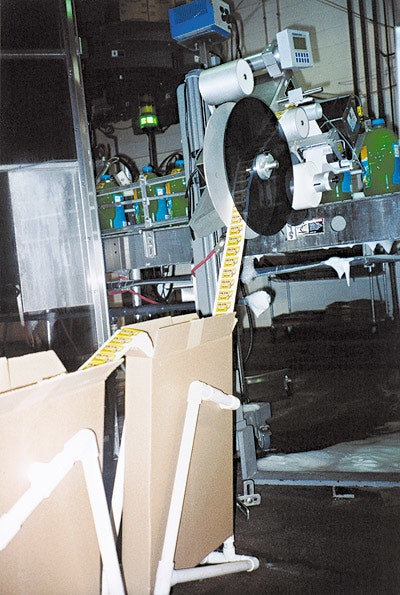
A terrible experience with promotional labeling a few years ago left Cadbury Schweppes’ facilities engineer Alan Jumper skeptical about the company’s promotional plans. The company wanted to apply an eight-panel, fan-folded promotional label to the shoulder of nearly 13 million 1-gal PET bottles this past spring.
“As soon as I [described how the project would be done], everyone in production said it couldn’t happen and just wouldn’t work,” says Jumper. Preferring not to divulge the previous project’s problems, he explains, “it was not a good experience. What made it successful this time was that the machinery technology is much better today with this type of applicator.”
This time, Rye Brook, NY-based Cadbury Schweppes Americas Beverages used four Model 3111 air-blow labelers from Label-Aire. The equipment was leased through Label-Aire distributor RayPress. RayPress is a promotional leaflet manufacturer that supplied the pressure-sensitive labels for the Hawaiian Punch bottles. Folded, the labels measured 13¼4”x21¼4”. The multipanel labels unfolded to about 61¼2” long.
Flexo-printed in four colors, the 60# coated one-side p-s paper labels also used a 1-mil polypropylene to protect the print beneath it. The carrier web was a 2-mil PP stock.
“We began applying labels on May 3 for a Memorial Day promotion that ran from May 24 through September 4 this year,” Jumper explains. The “unleash the punch” promotional contest involved 6- to 14-year-old entrants filling out an entry form printed onto the fan-folded label. Each entrant had to submit an original rap song of 50 words or less with an audio version submitted via an MP3 file, cassette tape, or CD. The grand prize was $10ꯠ and a chance to meet rap artist Bow Wow at a November promotional event. Other prizes were also awarded.
Machines yield multiple benefits
Jumper says the production run for the promotionally labeled bottles took around seven weeks at Aspers. “We fill the 1-gallon bottles 24/7 on two lines year-round,” he says. One line runs at 200/min, the other at 225/min.
“During this promotion, we used the fan-folded shoulder label, along with a wraparound label printed with information about the contest.”
The Label-Aire equipment impressed Jumper for several reasons. First, “we added two Label-Aire labelers to both lines to apply the fan-folded labels,” he says, “and we did it without missing a beat on our line efficiency.”
During the run, the leading label was held in place by a vacuum grid on the 3111. At the precise moment when the 1-gal Hawaiian Punch bottle passed under the grid, air jets were activated to blow the label onto the bottle’s shoulder.
Using two machines for each line provided additional security. Jumper says, “If we’d have had a problem with one labeler, we could have taken it offline, done the appropriate repairs, and put the second labeler online so we wouldn’t have had to shut down. No other changes to the lines were required.”
Leasing the equipment also made sense. “Leasing is not something we do regularly,” he admits, “but in a situation where we’re only going to run for a short period of time, that was the sensible decision.” Leasing also eliminated the need for a capital equipment approval process, not to mention the actual financial outlay.
Another factor that proved beneficial to Cadbury Schweppes was hiring a RayPress technician for on-site equipment training on the labelers. “He was here for the first three days of production, and we ran about 40 of our people through the training. We took it from there, and there were no problems.”
A significant advantage, Jumper says, was not using rolls of labels. “What made it a much simpler process for us was that we did not go with the standard roll-fed labels. Instead, we used fan-folded labels that allowed us to do splices at line speed. With rolls of labels, you have to shut down to feed a new roll.”
RayPress custom designed the labels into a format somewhat like the old computer printer paper that unfolded from a stack. In this instance, 5ꯠ of the folded leaflet labels were placed in a box. The last leaflet from the box was affixed to the leading label from the next box to keep the equipment running. “We could do splices in a continuous process, without stopping,” says Jumper. He says that capability reduced downtime and labor costs.
Better yet, the experience for the “unleash the punch” campaign changed Jumper’s mind about promotional labeling. “Now I would have absolutely no reservations at all about using this exact type of equipment again. This promotion was a success.”

























